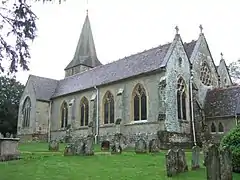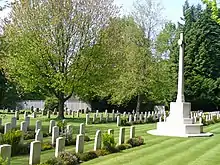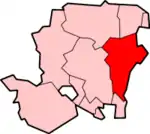Bramshott
Bramshott is a village with mediaeval origins in the East Hampshire district of Hampshire, England. It lies 0.9 miles (1.4 km) north of Liphook.
| Bramshott | |
|---|---|
 Church of St Mary the Virgin | |
 Bramshott Location within Hampshire | |
| OS grid reference | SU842329 |
| Civil parish | |
| District | |
| Shire county | |
| Region | |
| Country | England |
| Sovereign state | United Kingdom |
| Post town | Liphook |
| Postcode district | GU30 |
| Police | Hampshire |
| Fire | Hampshire |
| Ambulance | South Central |
| UK Parliament | |
The nearest railway station, Liphook, is 1.3 miles (2.1 km) south of the village.
History
The first evidence for the hamlet of Bramshott is the record of Matthew as its first Rector in 1225 and the early 13th century church. The parish evolved from the medieval manors of Brembreste (Bramshott today), Lidessete (Ludshott), Ciltelelei (Chiltlee), the royal forest of Woolmer and fragments of two other manors.
Bramshott Manor is described in the Domesday Book as held by Edward of Salisbury from the king with two freemen, thirteen tenants (of restricted freedom) and two mills. Ludshott Manor, lying to the north of Bramshott Manor, is recorded with four tenants and a mill. Chiltlee Manor lay to the south of Bramshott Manor and was recorded as being held by the king, William the Conqueror, with four tenants and land for two ploughs, worth fifty three shillings (£2.65). These four manors lay on the edge of the royal forest of Woolmer, with the origins of Liphook perhaps built as smallholdings to serve huntsmen.
The village grew until the 14th century but was checked by the Black Death. It seems some people escaped from the manors to Liphook to evade taxes of the Lord. Since the 16th century development of Bramshott has been intertwined with that of Liphook.

St. Mary's Church holds the graves of 318 Canadian soldiers stationed at nearby Bramshott Camp during the First World War, including many victims of the influenza outbreak of 1918-20.
Part of the ancient parish of Bramshott used to be in the county of Sussex, comprising an irregularly shaped protrusion of that county's territory containing Holly Hills and Griggs Green. This reached as far north as the lake at Canforth Park Farm.[1] In addition Bramshott had a small enclave within Sussex, comprising Croft House Farm near Folly Mere.[2]
Environment
Bramshott Chase is an area of National Trust woodland adjacent to the London-Portsmouth Road popular for walking.[3]
Notable people
The actor Boris Karloff, born William Henry Pratt in London, lived in retirement in Bramshott until his death in 1969.[4]
References
- Book of Reference to the Plan of the Parish of Bramshott in Sussex, Ordnance Survey 1874
- Ordnance Survey 6 inch sheet XLIV surveyed 1870
- "Woodland Trust: Bramshott Chase". Archived from the original on 18 April 2014. Retrieved 18 April 2014.
- "Boris Karloff's daughter visits Bramshott to help church". BBC News. 7 October 2012. Retrieved 7 October 2012.
Further reading
- Capes, W.W. (1901). Rural Life in Hampshire.
- Newman, Roger C. (1976). A Hampshire Parish.
- Finney, Joan; Wilson, Alan. "The Origin and Growth of Liphook: 1. Before the Coaching Age". Liphook Community Magazine. Summer. 2005: 16–17.
External links
| Wikimedia Commons has media related to Bramshott. |
- Anglican Churches of St Mary, Bramshott and Liphook Church Centre (link inactive November 2014)
- Historical information and links on GENUKI
